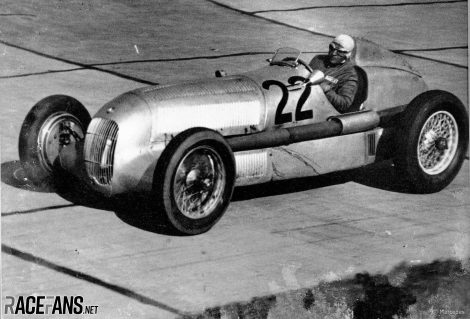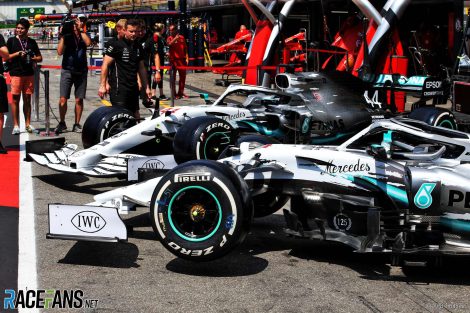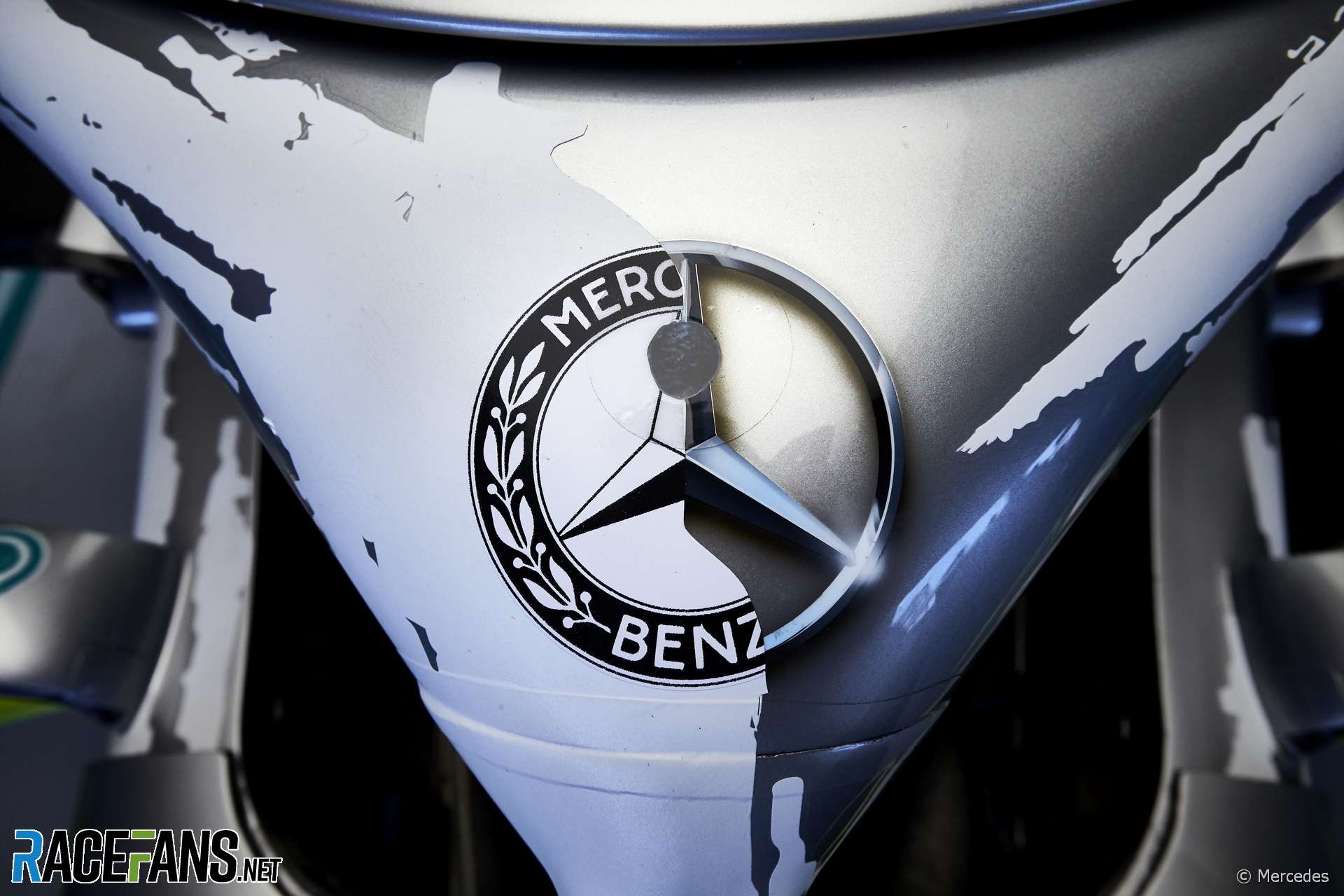Mercedes is celebrating 125 years of motorsport at its home grand prix today with a special livery which harks back to one of the most celebrated stories from its history.
However the tale of how the team scraped paint off its W25 cars 85 years ago in order to win a race at the Nurburgring Nordschleife is more fiction than fact.The story as related by Mercedes in their press release ahead of this weekend’s race is that the team removed the white paint from its cars at the 1934 Eifelrennen to get them under the maximum weight limit of 750 kilograms. The story is reflected in the bodywork of the W10s being raced by Lewis Hamilton and Valtteri Bottas this weekend, which are painted white at the front then have the appearance of being scraped away to reveal their usual silver livery beneath.
Alfred Neubauer, the team chief at the time of the 1934 race, made the same extraordinary claim about how it was won in his autobiography, which was published over two decades later.

According to Neubauer the team’s driver Manfred von Brauchitsch made a “chance remark” which inspired the scheme. “The whole night was spent removing the glossy white paint from the Silver Arrows. Next morning they turned the scales at 750 kilos exactly. And a few hours later von Brauchitsch clocked up the first victory for the new Mercedes racing car.”
However German journalist and author Eberhard Reuss painstakingly debunked what he called the ‘paint-scraping myth’ over a decade ago in his history of Mercedes and Auto Union’s pre-World War II racing activities, “Hitler’s Motor Racing Battles”. Reuss’s research for his book, which was published in 2008, amply justified his use of the word ‘myth’.
Advert | Become a RaceFans supporter and
Reuss obtained the official race regulations for the 1934 Eifelrennen and found that the 750kg weight limit, which had been introduced to grand prix racing that year, was not applied at this event. There were two classes of entrant for the race: Those limited to 1,500cc engines, and an “unlimited” class in which the W25s competed and won.
“There was simply no need for last-minute paint-scraping the night before the race,” he noted.

Reuss unearthed another gem of information relating to Neubauer’s account. Seven years before writing his memoirs, Neubauer wrote another book in which he also discussed the 750kg formula without mentioning the events of the Eifelrennen race. He did, however, refer to an article from a French magazine published in 1906, which told the story of a driver who had to scrape paint off his car to reduce its weight.
Von Brauchistch did not mention the paint-scraping story in his 1953 autobiography, Reuss notes. It was added when he republished them six years later – after Neubauer’s memoirs had been published.
While Mercedes has chosen to reflect the story on its cars this weekend, it is not making any claim the tale is actually true, and has carefully referred to it as a “legend”.
Ironically, applying the special livery had the opposite effect on its current cars. “I can tell you it’s definitely not making the car lighter,” admitted Toto Wolff yesterday, resplendent in his Neubauer-period garb, when asked by RaceFans. “In all the briefing sheets prior to this weekend the engineers pointed out ‘too heavy stickers’…”
Advert | Become a RaceFans supporter and
2019 F1 season
- Crying in the Melbourne car park at 2019 grand prix was my career low – Ocon
- McLaren Racing reports reduced £71 million loss in 2019
- Kvyat: Hockenheim podium last year was “my biggest achievement” so far
- How the FIA’s new encrypted fuel flow meter targets Ferrari’s suspected ‘aliasing’ trick
- “He smashed my office door”: 23 must-see moments from ‘Drive to Survive’ season two





Phylyp (@phylyp)
28th July 2019, 9:43
“anon” is vindicated :)
Ha ha, I love this closing paragraph.
bosyber (@bosyber)
28th July 2019, 12:28
Yeah, that’s a nice bit indeed @phylyp! And indeed as usual, anon is informative and truthful, which remains a bit ironic on a web forum too :)
I am glad that Mercedes do not actually claim the story is true, though I agree with anon that using this livery does give it more fuel; In the end, while I think the livery itself could have been better (in looks), the white nose, the retro logo’s and team kit, do really make it a fun, enjoyable thing to celebrate 125 years of Mercedes. It is also a good thing for Hockenheim, even if it is to be their swan song, at least they have some memorable pictures and stories to show.
BasCB (@bascb)
29th July 2019, 18:48
Currently it looks like they will bow out like Valencia did – with a race that is one of the more memorable ones in recent history @bosyber!
JC
28th July 2019, 9:46
“Legend” has it Ferrari recruited these engineers who are now responsible for checking turbo and fuel systems.
Phylyp (@phylyp)
28th July 2019, 9:54
Aaah, cheer up, mate. Maybe today’s the day Ferrari does a 1-2 in front of the Mercedes’ home crowd, and breaks Mercedes’ spirit for the rest of the season.
Now excuse me while I choke to death laughing.
Shimks (@shimks)
28th July 2019, 10:15
You guys are so mean! :@)
Arrows98 (@arrows98)
28th July 2019, 16:11
@phylyp
weeeell, you’re not quite right, but… :)
Phylyp (@phylyp)
28th July 2019, 16:15
@arrows98 – ha ha, I am actually quite gobsmacked, and happily so. Vettel wasn’t the driver I expected to bring his car home in one piece! Today’s race was something.
MG1982 (@mg1982)
28th July 2019, 9:55
Wow, Hollywood at its finest, uh?! The way things unfolded this weekend so far have a Hollywood-esque feel big time, especially that it happens only to HAM and Mercedes: being 2nd/3rd fastest team all sessions until Q2, HAM being ill and on the verge of being replaced, hot temps, the car not performing…. then booom, fastest man on-track and PP. The hero (= HAM) saved the world…… F1 (sorry) again!
Jimmi Cynic (@jimmi-cynic)
28th July 2019, 10:21
@mg1982: Netflix may become the primary sponsor of F1. If they aren’t already writing the scripts.
Steve (@)
28th July 2019, 10:08
I loved the way SkyF1 did a corporate whitewash over the nazi era and tried to claim the 1950s as the classic era……..purposefully forgetting Manfred von Brauchitsch and the Silberpfeil.
Gabriel (@rethla)
28th July 2019, 12:04
Whitewashed the nazi era? ;)
Steve K
28th July 2019, 13:25
Why should we let the truth ruin a good story? Props to Mercedes for taking a page from NASCAR’s Darlington weekend. It has been fun.
Joseph (@bigjoe)
28th July 2019, 13:48
This Mercedes team has nothing to do with the legacy team we remember in history. It’s just a bunch of dishonest money thrown at someone else’s success.
It’s rather telling, in context with Ferrari, their engineers are quite dull in celebrating home wins.
Bobby (@f1bobby)
28th July 2019, 15:36
Don’t let the truth spoil a good story!
endeavour_morse
28th July 2019, 22:59
The thing is that the silver cars were always painted silver. It was never bare metal. A conscious decision was taken in 1934 because Mercedes-Benz and Auto Union represented (and were up to 60% funded by) the Third Reich.
White was the racing colour of the defeated Second Reich and the hated Weimar Republic. Silver was a new beginning for the great and glorious Reich that was being built…
Don Alfredo’s memoir always got a little bit shaky over anything that might implicate the team in politics of the 1930s. Herr Reuss is always to be thanked.